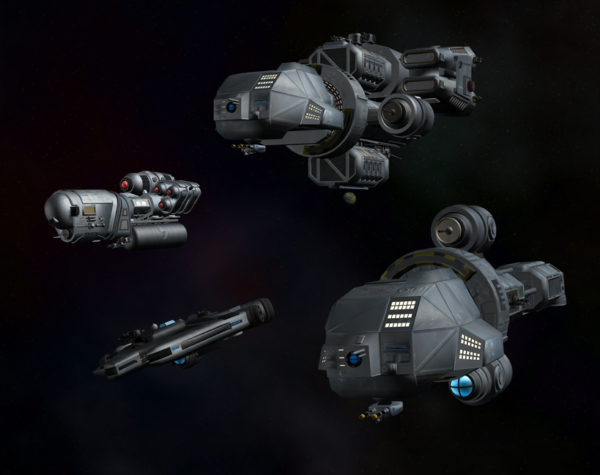Way back in issue 10 of the Frontier Explorer (has it really been over 5 years?!?) I wrote an article entitled “How Many Ships Are There?” (p.27) where I examined the number of starships that could be supported in the Frontier given the stated number of starship construction centers and the ship construction and maintenance rules. The answer came out to be around 1500 ships, not a lot to spread around the 17 systems and Spacefleet.

In that article I talked about some of the implications of that small number and some of the ways you could increase the number of ships flying around. If you haven’t already read that article, I recommend you do so as I’ll be building on some of the work there. Although it’s not necessary to follow along.
While I’m very much in favor of small ship numbers, I think that even this is too small for the setting and in this post I’m going to examine the numbers and methods of ship production and maintenance and see what impacts that has on ship numbers.
At least part of the desire to look at these numbers stems from some campaign background work I’m doing related to the Second Sathar War and how the Frontier would respond to the new Sathar incursion. So let’s get started.
The Baseline
To start with, we need to have an idea of what the base production and maintenance rate in the Frontier is so we can see how changes we make affect that.
When I wrote the article for the Frontier Explorer, I created a Python program that would simulate the starship construction centers, their waiting queues, and handle all the book keeping. That is how I generated the numbers for that article. So the first step was to dust that off and get familiar with the code again. If you’re interested, it is in this GitHub repository. There is no documentation and it’s really rough but you’re free to play around with it.
Since we’re just going to be looking at variations, I’m not trying to reproduce the exact numbers from the Frontier Explorer article. In fact, I’m going to use a very different distribution that gives me more ships as a baseline than the number from that article.
For this article, the distribution I’m going to use is one that has roughly equal numbers of ships hull size 1 to 10 (~6.6% each) and then falling off beyond 10 so that there is only about a .5% chance of building a HS 20 ship. This weighs the distribution toward smaller ships. As I pointed out in the original article, the smaller the average hull size of the ships flying around the Frontier, the more ships the canonical starship construction centers (SCCs) can support. The average hull size of ship produced is 6.5.
I’m also making a few other assumptions. First, I’m treating these all as civilian ships, so any ship can be built at any SCC as long as it is less than that SCC’s maximum hull size limit. Also, I’m not factoring the hull availability rules into the simulation. I’m assuming any size hull is always available. Finally, I’m ignoring the “only system ships” restriction on the smaller Class III construction centers. I’m only interested in counts, not types.
The other “feature” of the simulation is that it doesn’t really handle the queuing of hulls waiting to be built in the best manner. It simply looks at the available space and finds the next ship in the list that will fit. What this means is that larger ships tend to get passed over as there is never any room for them. This also tends to skew the ships sizes toward the smaller hull sizes over time.

With this ship distribution and those assumptions, the SSCs listed on page 9 of the Knight Hawks Campaign book can support about 2300 ships. Which is already a significant improvement over the 1500 ships from the original article. If you’re curious, reversing the distribution (ramping up to HS 11 and flat thereafter, only allows the system to support about 1250 ships).
Supporting More Ships
Now with that baseline, let’s look at increasing the number of ships we can support. There are several factors that go into the final number: total capacity, ship size distribution, construction time, and maintenance time.
I’m not going to play with construction time. That actually would have little effect on the total number as the steady state is purely based on the other factors, which are somewhat related to each other. Let’s look at some options.
Double the Number of SCCs

The canonical set of SCCs has a total capacity of 510 point of hull size across the nine lists construction centers that can be under construction or in maintenance. Let’s start by just doubling that number. Let’s add 9 more SCCs across the Frontier that are clones of the existing nine. We’ll keep the other parameters the same and start up a new simulation.
Running the simulation with the increased number of SCCs results in the Frontier being able to support about 4100 ships, and increase of 1800 ships of about 80%. It doesn’t double as the increased capacity allows a few more larger ships to get built right at the beginning and the average hull size of ships produced jumps from 6.5 to 7. Since the average HS is larger, the total number is less than 2x based on the 2x capacity.
Planetary Small Ship SCCs
What if we try increasing capacity in another way. Instead of just cloning the existing SCCs, let’s give each planet a small SCC that can only build ships up to HS 5 and can handle 20 hull size points of ships at a time. This represents each planet being able to build and maintain it’s own fleet of shuttlecraft and small system ships separate from the main SCC.
If you drop those 22 SCCs (I didn’t give one to Volturnus) into the Frontier, that adds in another 440 hull size points of capacity. Since we should skew to smaller hull sizes being built, we would expect to get a good increase in the number of ships, possibly more than double. Unfortunately, that isn’t what happens. since we didn’t change the distribution of ships we’re drawing from, these small SCCs get underutilized. The total only goes up to about 2400.
I think a bit of this is a queueing problem so let’s just run a simulation with only those new SCCs, but using the same input distribution. I this case we get the system sustaining an additional 300 ships with an average hull size of 3. Still not exactly what I was expecting.
But that distribution doesn’t really make sense. And I think there is still some sort of bug in my code that isn’t doing the queuing properly. So let’s give these smaller SCCs their own queue and distribution. We’ll only pick ships from HS 1-5 for them to build and just make it a flat 20% chance of each hull size. Running that simulation give us that the smaller SCCs can support ~7000 additional ships with an average hull size 2.9. Dividing that between the 22 planets gives us an additional ~320 ships per planet.

That definitely points to something strange happening with the queue when using all the SCCs in a single run. It’s supposed to be dropping the larger ships that are getting passed over after a while but that doesn’t seem to be happening. Or at least not fast enough to fill the smaller SCCs. I’m definitely going to have to look into the queue system I’m using and this may impact the baseline numbers as well (increasing them).
But that means that adding in these small SCCs at each planet increases then number of ships that we can have flying around from 2300 to nearly 9300, an increase of 400%. They are mostly small ships but that may be what you need for all the transport to and from the surface of the planet and within a star system.
Reducing Maintenance
The previous 2 variations just looked at increasing SCC capacity. What if we look at simply reducing the amount of maintenance that a ship needs in a SCC. If ships have to spend less time in the SCC for repairs, then that space is available for new ship construction.
The KH rules say a ship needs to come in every year for 1d10+HS days of repair. And every year they don’t adds a 5% chance of failure of a critical system on a jump and when they do finally get in adds 1d10 days of repair per year missed.
Let’s reduce that. For this try, we’re going to say that they only have to come in once every five years, and that it is still only 1d10+HS days of work to get the maintenance done. Maybe routine maintenance by the crew is enough. Maybe there are dedicated “repair yards” that can handle the work the other years. Whatever the reason is, we are not tying up the limited SCC space with ships undergoing maintenance. We’re going to jump straight to five year so we can see if this is a large effect or not.
Going back to our baseline configuration with just the canonical SCCs and the original ship distribution, this new maintenance requirement results in a new ship count of 6500 ships with an average hull size of 7.0. That’s an increase of ~280%. So we’re getting more and slightly bigger ships. I knew going in that the maintenance was the true bottleneck. I didn’t get quite as many more ships as I was expecting but it’s a significant increase.
However, the simulations I’ve been running only simulate 100 standard years. That’s usually more than enough time to reach a steady state and longer than the history of the UPF at the time of the Second Sathar War. Interestingly, in this simulation, it never really reached that steady state, the numbers of ships were still going up at the end of the simulation. So for fun, I rand both the baseline and the low maintenance option again for a 200 year simulation.
In that case, we did reach a steady state of the number of ships in the low maintenance simulation of 8500 ships with an average HS of 7.1. The baseline sim only went up to 2850 ships with an average HS of 6.25. We got more ships but on average they are smaller. So the low maintenance option represents an increase of 300% over that new baseline. But it’s going to take the Frontier some time to get to that level.
Conclusions
As expected, increasing the number of SCCs increases the number of ships that can be supported. The simulations have given some number to those increases. What I wasn’t expecting was the impact the queuing system I was using would have on the outcome. Obviously a queue that generates ships of the appropriate size for a given SCC distribution can have an effect on the final numbers.
What we found was that just doubling the number of SCCs with the same capacity profile basically doubled the number of ships. That’s probably a good rule of thumb. But if we increase the capacity and limit the ships to smaller hull sizes, we get a huge increase in the number of ships. Limiting the ships to HS 5 or less and with only an 86% increase in production capacity, resulted in a 400% increase in the number of ships.
The other unsurprising bit was that reducing the amount of maintenance required resulted in more ships being supported, I was expecting a nearly linear increase but that wasn’t the case. At least partially because we ended up with more of the larger ships which reduces the total capacity. What was surprising was in the low maintenance model, 100 years of simulation wasn’t enough to reach a steady state on the number of ships.
The truth is, you can have as many ships flying around as you want. If you have more, you can add flavor to your game to describe the extra ship construction capacity any way you want. Then just take the rules as written as the resources available to the PCs. There is more capacity out there, they just can’t access it.
What’s Next?
There are still more things to explore on this topic. Probably the most obvious is looking more closely as the algorithm I’m using to queue up the ships. That apparently has a bigger impact that I was realizing. It was supposed to model the process described in the rules for getting a ship into an SCC but maybe it’s not doing that well enough.
The other aspect might just be the ship distribution I’m generating. Another area to explore is looking more closely at the number and types of ships that are out there flying around and building up a “realistic” distribution based on that. I have looked at that issue in the past and maybe will do a post about it. It produces a different distribution than the one I used here but I’m not sure I really captured everything.
Another thing to consider is the distribution of SCCs. I did some fairly arbitrary changes for this article just to look at gross effects. A more nuanced look at increased capacity might be interesting.
What ideas do you have? Are there specific things you’d like me to explore? Let me know in the comments below.
When figuring in the number of ships, would ships outside of the area shown in the Frontier be figured in? such as cargo ships and military ships whose bases are just outside Frontier space. Two wars with a hostile species all the involved governments would do more to safeguard not only their territories but also seek to stem the growth of the hostile species.
Another thing is dedicated military SCC centers, these would more than likely outside of Frontier space to keep them safe from said hostile species. the ones inside Frontier space would probably be made into explorer outpost or scout outpost like in Traveller rpg. With the Sathar in the picture after a 2nd time, I would believe that the governments in the Star Frontiers universe would be taking major measures to contain the Sathar threat.